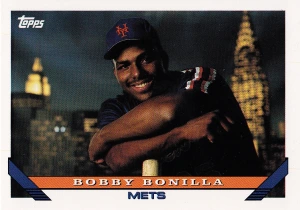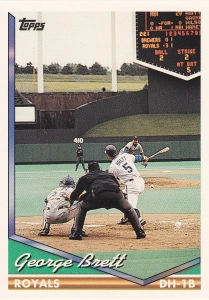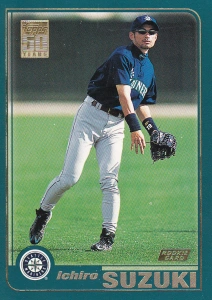 Topps again issued a 132-card “Traded” set in 1991 in the same fashion as previous years; cards were numbered in alphabetical order, separately from the base set with a “T” suffix as #1-132. The set contains cards of rookies who didn’t have a card in the base set, players who signed with or were traded to new teams, new managers, and a Team USA subset. The design was essentially the same as the base set (though I think there are some slight color differences). The cards available in factory sets were again printed in Ireland on white cardstock.
Topps again issued a 132-card “Traded” set in 1991 in the same fashion as previous years; cards were numbered in alphabetical order, separately from the base set with a “T” suffix as #1-132. The set contains cards of rookies who didn’t have a card in the base set, players who signed with or were traded to new teams, new managers, and a Team USA subset. The design was essentially the same as the base set (though I think there are some slight color differences). The cards available in factory sets were again printed in Ireland on white cardstock.
The card set comes with a Topps Magazine advertisement, similar to the set they had two years ago (the 1990 set didn’t).

There were two different boxes that the factory sets could come in. The first is a green box (shown to the left) with the exact same design as the sets from the previous years. For the third year, Topps also issued the set in a flatter, more colorful box that looked very similar to the “Holiday” factory sets for the flagship set. Just like those Holiday sets, the more colorful packaging was issued to retail outlets. From the picture below – Billy McMillon from Team USA is shown, but I’ve also seen a box with Brett Butler’s card.

For the second straight year (and third overall, though 1985 was just a test release), Topps also issued the Traded set in wax packs, 7 cards per pack and 36 packs per box. Neither the box nor the packs have a SRP listed; the base cards were 50¢ for 15 cards, my guess would be that these ran for 25¢. Unlike the factory sets, the cards in the wax packs were printed on the same gray cardstock as the base set.

 Keeping with previous years, dealers who ordered cases of the Topps Traded set also received a miniature Bronze Card – this time a replica of Brooks Robinson’s rookie card from the 1957 Topps set. For the final time, Topps also issued a Tiffany set that had a glossy picture on the front – just like the base set, this was the last year and was more limited than previous years.
Keeping with previous years, dealers who ordered cases of the Topps Traded set also received a miniature Bronze Card – this time a replica of Brooks Robinson’s rookie card from the 1957 Topps set. For the final time, Topps also issued a Tiffany set that had a glossy picture on the front – just like the base set, this was the last year and was more limited than previous years.
There are no Big Red Machiners in this set, and there is one card of a 1990 World Champion.
- Danny Jackson, who the Reds let walk after the 1990 season. Jackson more than doubled his salary – signing with the Cubs for $2.6 million.

There are 7 Hall of Famers in the set. At the time I posted this – there were only 2!
- Gary Carter was in his second straight traded set. After a season as the backup catcher for San Francisco, Carter signed on for the same role in Los Angeles.
- In July 1990 in one of the bigger trades in recent memory, Roberto Alomar went along with Joe Carter from San Diego to Toronto for Fred McGriff and Tony Fernandez.

Since I posted this – Jeff Bagwell, Fred McGriff, Jack Morris, Tim Raines and Ivan Rodriguez have all been elected! See their cards below!
Like the 1988 set did, this set had a Team USA subset. This was for the team that played in the Pan American Games, placing 3rd behind Cuba and Puerto Rico. Interestingly, Topps actually included guys who still played college baseball after 1991 (unlike the 1988 and 1985 sets). Not sure how that worked contract-wise, but there are some fairly good major leaguers in this subset. Most notable is Jason Giambi, but Charles Johnson and Phil Nevin had good careers (though Nevin was so highly touted – his is considered a bit of a bust). Speaking of bust – the first card for Darren Dreifort is in this set. Ron Polk, the head coach, was a long time manager at Mississippi State, and has the 8th most all-time wins in NCAA baseball.

There are quite a few other RC’s worth mentioning. Jeff Bagwell and Ivan Rodriguez will probably be moved up to the Hall of Fame category some day (though maybe Pudge’s steroid accusation will keep him out. Mo Vaughn (1995 AL MVP), Steve Finley (300-3oo club) and Luis Gonzalez (57 HR in 2001) all had very good careers. By the way – I think the 4 most clutch World Series performances of my lifetime are in this set. First is Gonzo below – his walk-off single in game 7 against Mariano Rivera ended the Yankee domination of that era.

There were also some other good rookies available in this set, a tier below the guys above. Mitch Williams – see below re: Joe Carter.

And there were some good veterans available, too. The rest of the Alomar trade is in the set – Joe Carter would end up proving that trade worthwhile when he hit the 2nd walk-off HR in World Series history a few years later. But I’d argue Jack Morris had the most impact on his team and the most clutch performance of this group – his 10-inning shutout of the Braves in game 7 of the ’91 series is one for the ages. Interesting – Terry Pendleton was the league MVP in ’91, his first year with the Braves.

It’s funny how you have to go down the list to mention Strawberry – remember how big of a deal it was when he went to LA?
Next up, there always seem to be two categories of veterans in these Traded sets. First, is the impact guys – see above. But there are always quite a few “over the hill” guys just hanging on for a few more years. This group has the 4th “clutch performer” I mentioned above, though this is the only one that wasn’t a series clincher and the only player that had already had that performance by 1991. I’m thinking of Kirk Gibson, of course, who was on his way to the Royals, 2+ years after hitting a memorable walk-off homer in game 1 of the ’88 Series off Dennis Eckersley.
































































